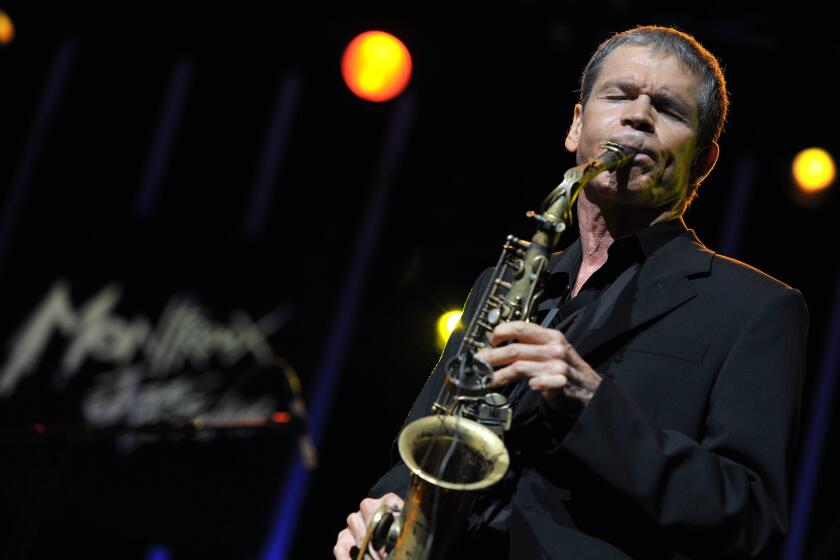What’s new in country? A song of love gone bad
The country music industry expected this to be a bountiful year. Record executives here banked on several of its biggest stars, especially the women who carried the genre through the late ‘90s, to soar to the top of the charts with new releases.
But instead of soaring, the women sputtered. Some even crashed.
Two of the genre’s superstars, Shania Twain and Faith Hill, released long-awaited albums last fall that aimed more aggressively than ever for across-the-board success, hoping to ring the bell in several radio formats. The results, however, alienated country radio and failed to inspire much support from pop radio.
And when radio isn’t happy with an act, the lack of airplay usually contributes to a sharp sales decline.
Twain’s recent “Up!” stalled around the 4-million mark; her previous album, 1997’s “Come on Over,” sold 14.7 million copies in the U.S. Hill’s sales have fallen from the 6.2 million of 1999’s “Breathe” to 2.5 million for her latest, “Cry.”
“Faith and Shania simply didn’t deliver much country music this time around,” says Brian Landrum, program director for Nashville radio station WSM. “Their images and videos seemed to take big steps away from country and toward pop. The perception was that there just wasn’t a whole lot there for us.”
Jaye Albright, a leading country radio programming consultant with Seattle-based Albright & O’Malley, says the rejection hit country stations in big cities and rural areas alike.
“To be honest, country radio was disappointed with their records,” Albright says. “They weren’t even a little bit country.”
The Dixie Chicks, another female superstar act, flew smack into a different public relations problem. The trio’s album “Home” received a hero’s welcome when released last summer, but sales declined drastically after member Natalie Maines told a London concert audience in March that she was “ashamed” that President George W. Bush shared the group’s home state of Texas. The album had sold 5.1 million copies in the U.S. before the remark, and a little more than 500,000 since. Many country stations stopped, or sharply reduced, airplay for the group’s music because of Maines’ remark.
With three leading female acts on the outs with radio programmers, country music suddenly was dominated by male acts for the first time since the Garth Brooks explosion in the early ‘90s.
“There’s definitely a movement back toward the manly men of country music,” says Terri Clark, one of the few female country performers to enjoy a major hit this year -- her song “I Just Wanna Be Mad” reached No. 2 on the Billboard country chart. “Toby Keith is doing great. Kenny Chesney is doing great. Alan Jackson is doing great. Some of the rest of us are doing OK.”
The shift came because world events “changed the hearts and minds of country fans,” Clark says. “They wanted to go back to basics, back to meat-and-potatoes music. Real country music became popular again. It’s middle American, it’s blue collar, it tells it like it is -- and that’s what people want from music right now.”
Twain, Hill and the Dixie Chicks aren’t the only female artists missing from the charts. Lee Ann Womack, LeAnn Rimes, SHeDAISY, Mindy McCready and other former million-sellers faced rejection with recent albums. “The problem with how country radio treated the Dixie Chicks is that there [wasn’t] anyone there to take their place,” says Brian Phillips, senior vice president and general manager of MTV-owned Country Music Television.
The result is a seismic shift in the success ratio of female-to-male songs on country radio. Of the 34 top 10 country hits on the Billboard chart in the first six months of 2003, only four were by women. The Dixie Chicks’ “Long Time Gone” was the only No. 1 hit, with Clark’s “I Just Wanna Be Mad” hitting No. 2 on Billboard and No. 1 on the rival Radio & Records trade chart. In 1998, in contrast, women accounted for 30 Top 10 hits, 13 of which went to No. 1.
“A specific set of circumstances led to this,” says Joe Galante, chairman of the RCA Label Group. “A lot of it was timing. Several successful female artists that you’d expect to be on the top of the charts made records based on the environment of the moment, but by the time the music came out, the format had undergone a significant change. Their music leaned more toward pop, while the format leaned more toward traditional. As a result, they didn’t have the success they wanted.”
Singer Patty Loveless believes another factor may be in play in the shift toward traditional music. “The audience that was listening to Faith and Shania five years ago is older now,” she says. “It may be that they’re listening to more adult music, whether it’s Norah Jones or the Dixie Chicks or something else.”
An 18-year veteran, Loveless is a roots-leaning singer who took a side turn during country’s pop phase by releasing a bluegrass album, “Mountain Soul,” and participating in the “Down From the Mountain” tour, an offshoot of the successful “O Brother, Where Art Thou?” soundtrack. She’s returning in September with a new album of rootsy material, “On Your Way Home.” The first single, a remake of Rodney Crowell’s “Lovin’ All Night,” is climbing the charts.
Loveless believes that in the wake of the crossover success of Twain and Hill, Nashville female artists were under the gun to focus on pop sounds and glamorous images. “There was a lot of pressure on the girls, especially the newcomers, to be sexy, hip women and to keep that image up in their videos and their songs,” she says.
Albright, the country programming consultant, noticed that a glut of young females flooded the country record racks in the late ‘90s, but few were successful.
“Every label started releasing albums by young women, and nearly every one of them seemed to model themselves on Shania or Faith or LeAnn Rimes,” she says. “So many of them sounded like young adult-contemporary singers with a fiddle on the track. There was an oversupply of them, and at some point there was a backlash.”
Indeed, at the annual Country Radio Seminar convention in Nashville, a major topic in recent years was the loss of the male listening audience for country radio. “Men don’t like wimpy female anthems,” Albright says. “Most radio stations started working hard to bring back male listeners.”
Jim Ed Norman, president of Warner Bros. Nashville, asserts that the best artists need to feel free to follow their creative instincts without concerning themselves with the reaction of fans or radio programmers. “To grow, artists need to take chances and develop,” says Norman, who signed Faith Hill to the label in 1993.
“Faith has constantly challenged herself, but that also means she’s challenged her audience. The more established you become, the harder it can be to overcome people’s expectations, and there can be negative consequences to that. An audience will let an artist know when they’ve gone too far.”
What bothers him most, Norman says, is the perception that Hill made a calculated move that backfired -- and that she and her advisors should’ve known better.
“People talk about these things as if someone should have been smarter than to have let it happen,” he says. “But that’s not how freedom of expression works. Anytime you work with an artist, especially one of Faith’s caliber, you want to give them the freedom to take the step forward they feel inspired to take. You don’t know how people will respond to it. If you act out of fear, you’ll never grow.”
Martina McBride, a veteran female artist whose career has continued to grow over the last few years, looks at the recent tribulations of country’s biggest stars and worries that the format has begun rejecting its top talents too quickly.
“There’s no consistency anymore,” says McBride, who has won the Country Music Assn. female vocalist of the year award for two consecutive years. “It used to be that if you were on a roll, you’d do well with several singles in a row. Now it seems that just because you’ve had a big hit, there’s no guarantee the next song will get any attention at all. It’s hurting careers, not just for the big stars, but for those coming up. I don’t see a lot of good in that.”
Warner Bros.’ Norman, for his part, hopes the debate leads to positive results for both superstar artists and country radio.
“The dialogue we’re going through right now is positive,” he says. “We’re all openly discussing what’s best for the format. Artists like Faith Hill are smart. They’ll take the information they’ve received, and they’ll incorporate it with their own inspirations and aspirations, and they’ll return with another artistic statement. It’s all part of the process.”
More to Read
The biggest entertainment stories
Get our big stories about Hollywood, film, television, music, arts, culture and more right in your inbox as soon as they publish.
You may occasionally receive promotional content from the Los Angeles Times.






